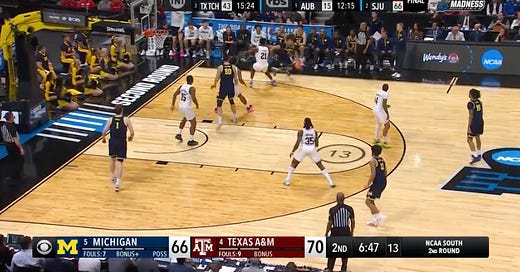How a Dusty May masterclass sent Michigan to the Sweet Sixteen
A two-parter: one on Michigan, one on inflation
I had originally planned out some sort of Why The First Round Sucked in ‘25 post centered around the infamous ‘it’s the money!’ bit, but this seemed more fun to do. Why spend your days dwelling on the bad instead of enjoying the good while it’s in front of you? Even if this Tournament hasn’t been terribly entertaining or fun, there’s been some fun stuff that has happened.
Since I had some free time today and don’t have another post planned until Thursday, I thought I’d do a notebook on two key things I noticed from the first weekend: one good, one bad. The good comes first, as it should.
Michigan’s May madness
Against UC San Diego in the Round of 64, Michigan advanced thanks to a couple of things: winning the battle of the boards in a close game and having slightly better deep shooting in a game where neither team shot particularly well. UCSD runs very little drop coverage, which was sort of a quality prep for Texas A&M, but UCSD switches/blitzes less than A&M does. It gave Michigan a bit more room to operate traditionally on the perimeter.
The difference between Michigan and most, though, is that Michigan features relatively few downhill attacks from their guards and wings. The players best at doing it are either a little too tall and turnover-prone (Danny Wolf) or haven’t hit much in the way of jumpers lately and are being collapsed on hard (Roddy Gayle). As such, Michigan more often uses perimeter drives or slashes as a means of creating enough gravity to either kick it out for a three or dump it off to a waiting big.
For the first 30 minutes of Saturday’s affair, A&M did a terrific job discouraging both. The Aggies’ defensive structure induces a ton of kickout threes, and generally, Michigan has utilized the post both as a source of interior and exterior offense, generating plenty of inside-out action from it. One thing they’ve quietly done relatively little of, though, are true spot-up attempts. On the year, Michigan ranks just 13th-percentile in usage of spot-ups. They still generate the majority of their threes from these, as any team does, but they take a pretty high number of threes in post kickouts and off-ball screens.
A&M, for the vast majority of this game, didn’t bother attempting to double on post-ups and completely obliterated a lot of Michigan’s off-ball actions. As such, a Michigan offense that normally averages 1.11 PPP in the first halves of games, per CBB Analytics, was held to 0.99 PPP thanks to a 40% outing on twos. The length of A&M harmed Michigan’s P&R in particular:
Michigan simply couldn’t finish, though, because Texas A&M felt pretty fine packing the defense in against a Michigan team shooting 27% from three in their last ten games. Because of how deep A&M was sitting, this led to a lot of open (and missed) Michigan threes.
In the second half, a few things happened. For one, Michigan was stunningly far better than Texas A&M on the boards, but it wasn’t due to hitting a lot of threes and drawing them out of the paint that way. Michigan went 3-11 in the first half, then 3-11 in the second. Turnovers were fairly similar half to half, too. But after a Texas A&M and-one pushed their lead out to 60-50, Michigan freshman L.J. Cason did something he’s done almost none of in the second half of games this year: drive the ball.
Here, against A&M’s zone press look, Jace Carter is slow to recover from the trap as Cason gets the ball deep on the right wing. Normally, Cason is a fine offensive player, but particularly later in games when on the court this year, he’s mostly been a guard that lurks on the perimeter waiting for a catch-and-shoot. Here, he spots his opportunity and goes for it.
That seemed to spark something in the team as a whole. Cason’s drive was an act of aggression they’d needed, but there’s something beyond the drive itself I notice immediately here: spacing that actually threatens the TAMU defensive structure. After this play, May and crew had finally found a way to create driving lanes without having to nail all their threes.



